Abstract
Radioiodinated transforming growth factor-beta 1 (TGF-beta 1) bound to the plasma proteinase inhibitor, alpha 2-macroglobulin (alpha 2M), as determined by chromatography on Superose-6 and native polyacrylamide gel electrophoresis. When alpha 2M conformational change was induced with methylamine, 125I-TGF-beta 1 binding significantly increased. Intravenously injected 125I-TGF-beta 1 cleared from the circulation of mice rapidly at first; however, intravascular radioactivity stabilized near 20% of the initial level. At necropsy, radioactivity was recovered predominantly in the liver (65%); however, the density of radioactivity (disintegrations per minute/g organ wt) was highest in the lungs. Markedly different results were obtained with purified 125I-TGF-beta 1-alpha 2M-methylamine complex. Clearance of the complex occurred as a first-order process with a t1/2 of 4 min. Greater than 90% of the radioactivity was recovered in the liver. The clearance and distribution of 125I-TGF-beta 1-alpha 2M-methylamine were equivalent to those observed with 125I-alpha 2M-methylamine and 125I-alpha 2M-trypsin. The latter two radioligands clear via specific alpha 2M receptors in the liver. Large molar excesses of alpha 2M-trypsin or alpha 2M-methylamine competed with 125I-TGF-beta 1-alpha 2M-methylamine for plasma clearance. Native alpha 2M, which does not bind to the alpha 2M receptor, did not compete. The receptor binding domain of alpha 2M-methylamine was blocked by chemical modification or enzyme treatment. The resulting alpha 2M preparations still bound 125I-TGF-beta 1; however, the complexes did not clear when injected intravenously in mice. The studies presented here demonstrate that alpha 2M can mediate the plasma clearance of a growth factor via the alpha 2M receptor system. We propose that alpha 2M, the alpha 2M receptor, and proteinases may function as a concerted system to regulate TGF-beta 1 activity and the activity of related factors in vivo.
Full text
PDF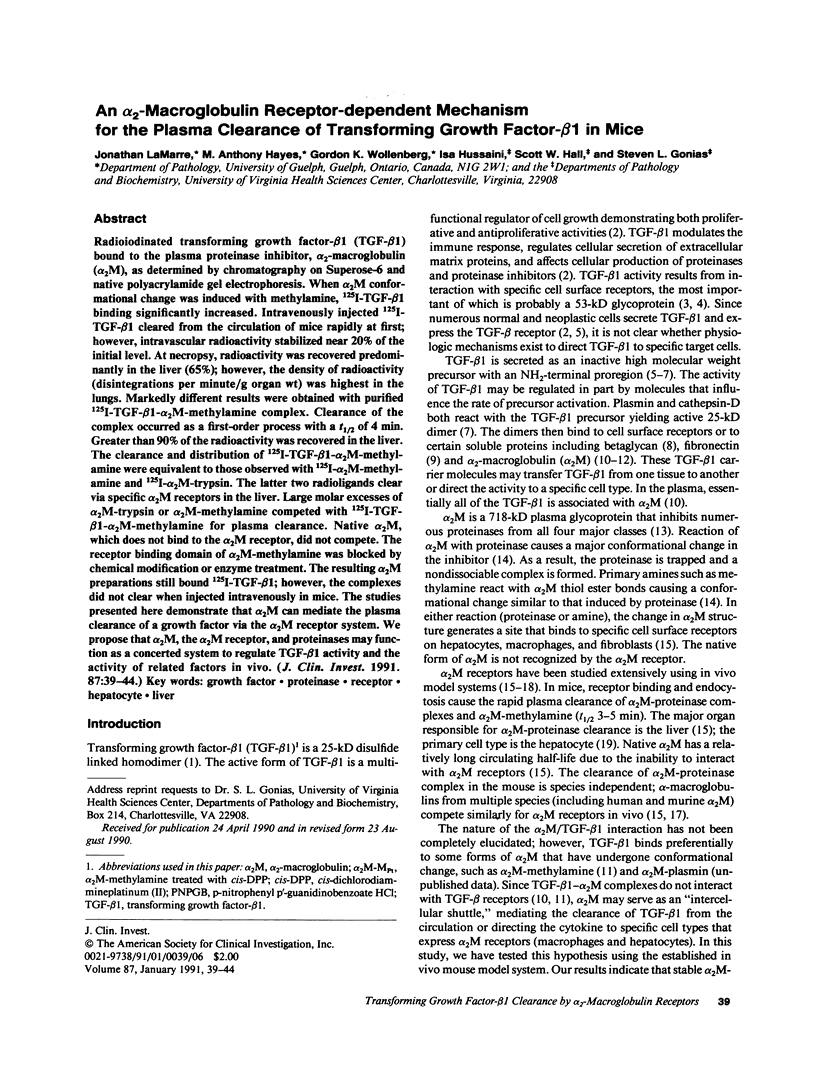
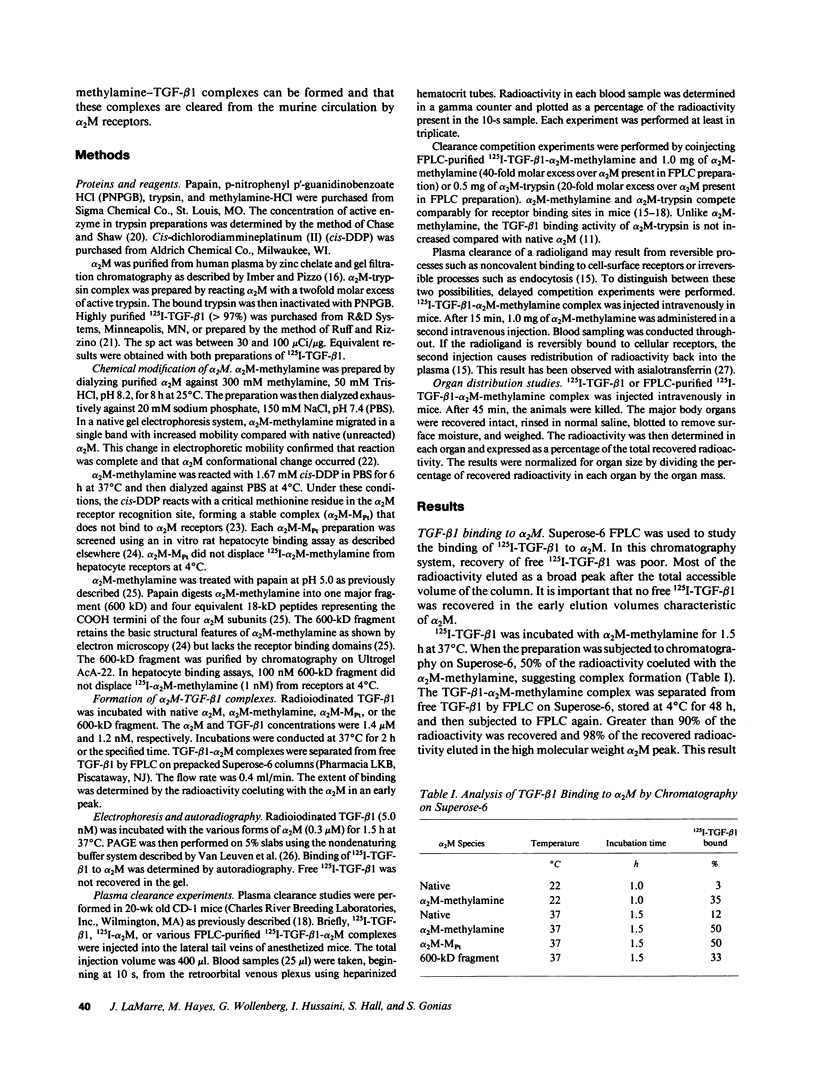
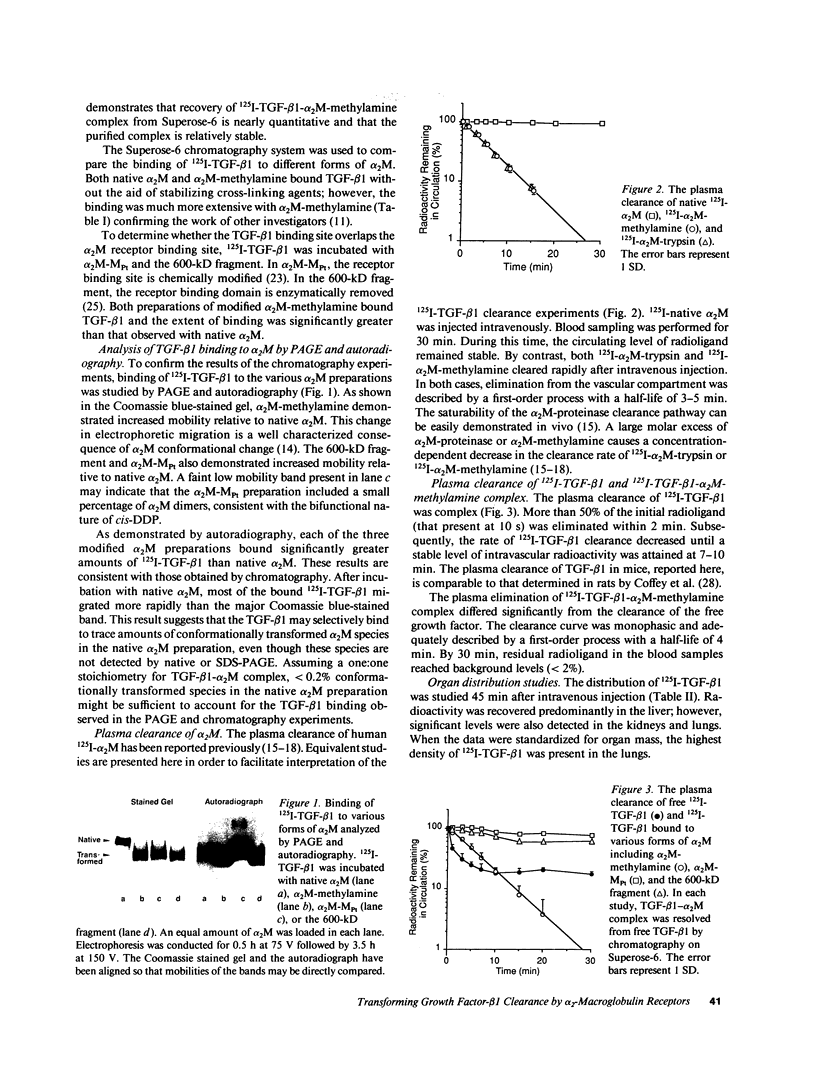
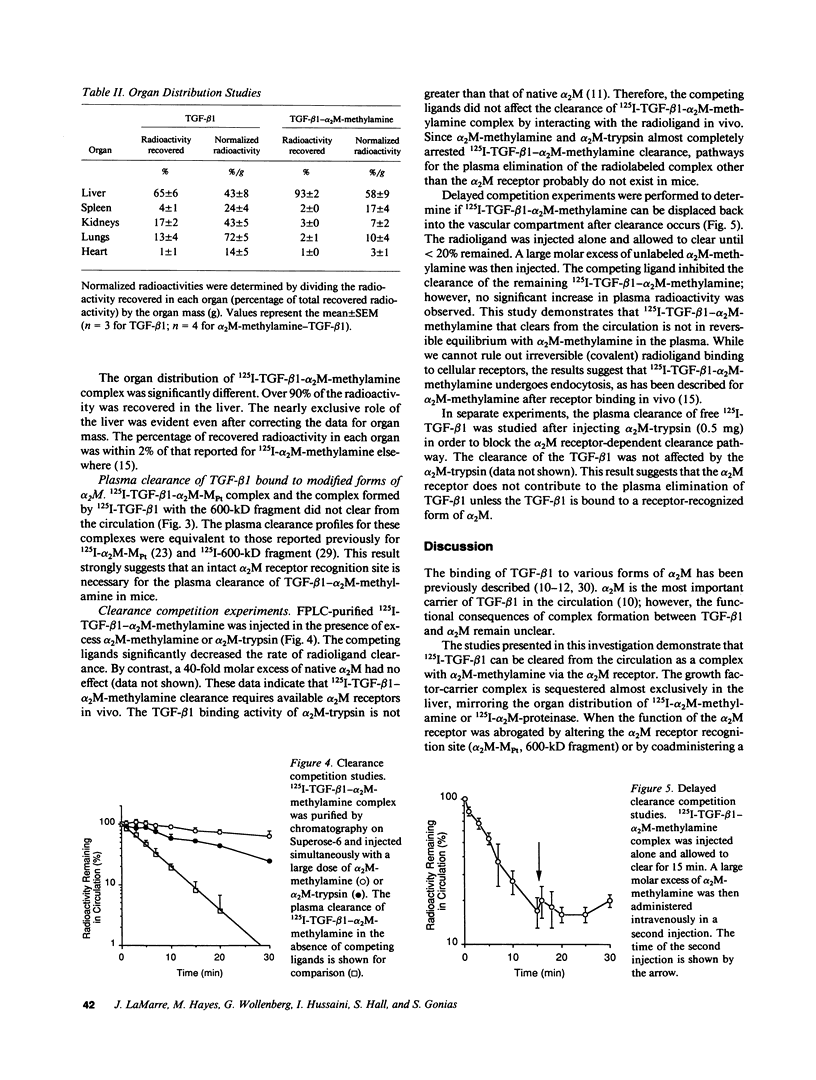
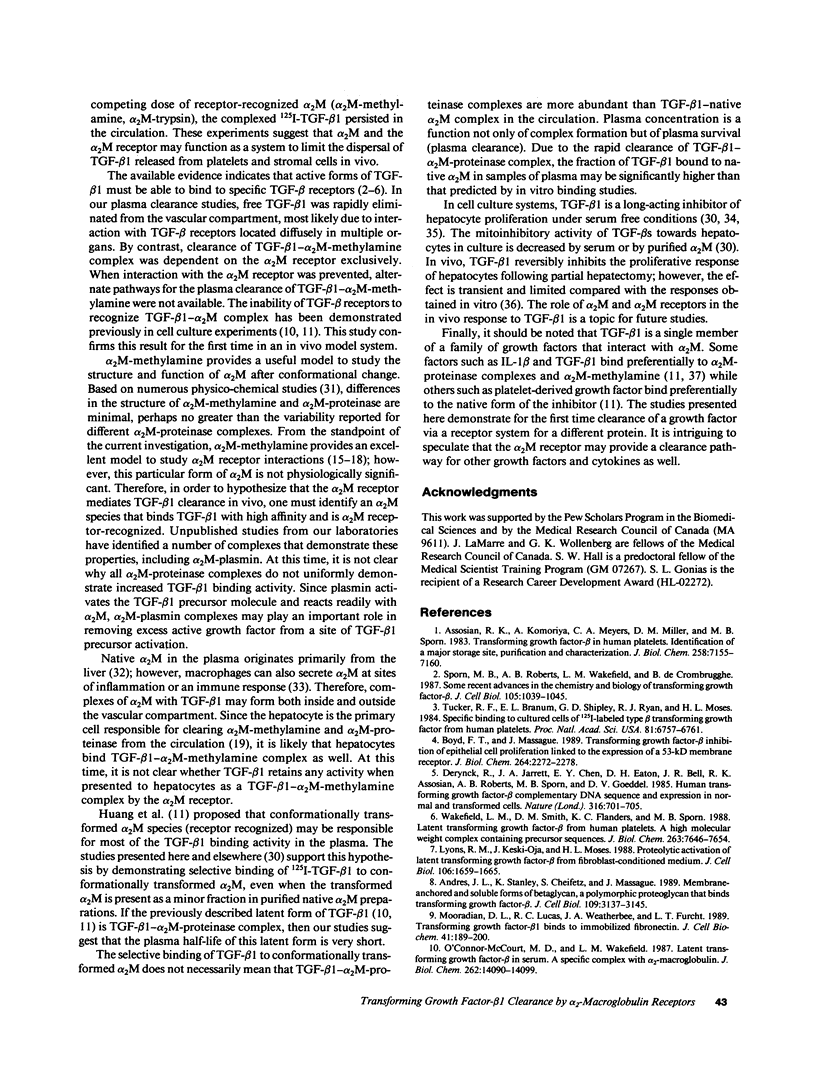
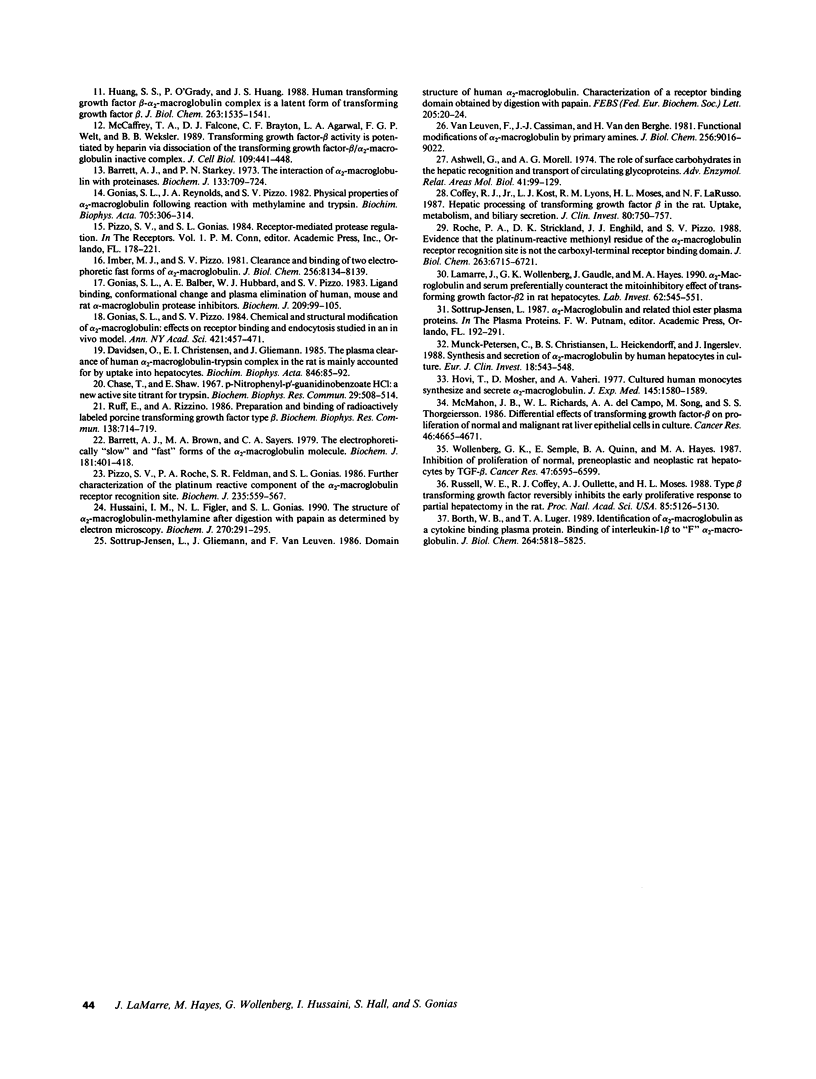
Images in this article
Selected References
These references are in PubMed. This may not be the complete list of references from this article.
- Andres J. L., Stanley K., Cheifetz S., Massagué J. Membrane-anchored and soluble forms of betaglycan, a polymorphic proteoglycan that binds transforming growth factor-beta. J Cell Biol. 1989 Dec;109(6 Pt 1):3137–3145. doi: 10.1083/jcb.109.6.3137. [DOI] [PMC free article] [PubMed] [Google Scholar]
- Ashwell G., Morell A. G. The role of surface carbohydrates in the hepatic recognition and transport of circulating glycoproteins. Adv Enzymol Relat Areas Mol Biol. 1974;41(0):99–128. doi: 10.1002/9780470122860.ch3. [DOI] [PubMed] [Google Scholar]
- Assoian R. K., Komoriya A., Meyers C. A., Miller D. M., Sporn M. B. Transforming growth factor-beta in human platelets. Identification of a major storage site, purification, and characterization. J Biol Chem. 1983 Jun 10;258(11):7155–7160. [PubMed] [Google Scholar]
- Barrett A. J., Brown M. A., Sayers C. A. The electrophoretically 'slow' and 'fast' forms of the alpha 2-macroglobulin molecule. Biochem J. 1979 Aug 1;181(2):401–418. doi: 10.1042/bj1810401. [DOI] [PMC free article] [PubMed] [Google Scholar]
- Barrett A. J., Starkey P. M. The interaction of alpha 2-macroglobulin with proteinases. Characteristics and specificity of the reaction, and a hypothesis concerning its molecular mechanism. Biochem J. 1973 Aug;133(4):709–724. doi: 10.1042/bj1330709. [DOI] [PMC free article] [PubMed] [Google Scholar]
- Borth W., Luger T. A. Identification of alpha 2-macroglobulin as a cytokine binding plasma protein. Binding of interleukin-1 beta to "F" alpha 2-macroglobulin. J Biol Chem. 1989 Apr 5;264(10):5818–5825. [PubMed] [Google Scholar]
- Boyd F. T., Massagué J. Transforming growth factor-beta inhibition of epithelial cell proliferation linked to the expression of a 53-kDa membrane receptor. J Biol Chem. 1989 Feb 5;264(4):2272–2278. [PubMed] [Google Scholar]
- Chase T., Jr, Shaw E. p-Nitrophenyl-p'-guanidinobenzoate HCl: a new active site titrant for trypsin. Biochem Biophys Res Commun. 1967 Nov 30;29(4):508–514. doi: 10.1016/0006-291x(67)90513-x. [DOI] [PubMed] [Google Scholar]
- Coffey R. J., Jr, Kost L. J., Lyons R. M., Moses H. L., LaRusso N. F. Hepatic processing of transforming growth factor beta in the rat. Uptake, metabolism, and biliary excretion. J Clin Invest. 1987 Sep;80(3):750–757. doi: 10.1172/JCI113130. [DOI] [PMC free article] [PubMed] [Google Scholar]
- Davidsen O., Christensen E. I., Gliemann J. The plasma clearance of human alpha 2-macroglobulin-trypsin complex in the rat is mainly accounted for by uptake into hepatocytes. Biochim Biophys Acta. 1985 Jul 30;846(1):85–92. doi: 10.1016/0167-4889(85)90113-2. [DOI] [PubMed] [Google Scholar]
- Derynck R., Jarrett J. A., Chen E. Y., Eaton D. H., Bell J. R., Assoian R. K., Roberts A. B., Sporn M. B., Goeddel D. V. Human transforming growth factor-beta complementary DNA sequence and expression in normal and transformed cells. Nature. 1985 Aug 22;316(6030):701–705. doi: 10.1038/316701a0. [DOI] [PubMed] [Google Scholar]
- Gonias S. L., Balber A. E., Hubbard W. J., Pizzo S. V. Ligand binding, conformational change and plasma elimination of human, mouse and rat alpha-macroglobulin proteinase inhibitors. Biochem J. 1983 Jan 1;209(1):99–105. doi: 10.1042/bj2090099. [DOI] [PMC free article] [PubMed] [Google Scholar]
- Gonias S. L., Pizzo S. V. Chemical and structural modifications of alpha 2-macroglobulin: effects on receptor binding and endocytosis studied in an in vivo model. Ann N Y Acad Sci. 1983;421:457–471. doi: 10.1111/j.1749-6632.1983.tb18139.x. [DOI] [PubMed] [Google Scholar]
- Gonias S. L., Reynolds J. A., Pizzo S. V. Physical properties of human alpha 2-macroglobulin following reaction with methylamine and trypsin. Biochim Biophys Acta. 1982 Aug 10;705(3):306–314. doi: 10.1016/0167-4838(82)90252-7. [DOI] [PubMed] [Google Scholar]
- Hovi T., Mosher D., Vaheri A. Cultured human monocytes synthesize and secrete alpha2-macroglobulin. J Exp Med. 1977 Jun 1;145(6):1580–1589. doi: 10.1084/jem.145.6.1580. [DOI] [PMC free article] [PubMed] [Google Scholar]
- Huang S. S., O'Grady P., Huang J. S. Human transforming growth factor beta.alpha 2-macroglobulin complex is a latent form of transforming growth factor beta. J Biol Chem. 1988 Jan 25;263(3):1535–1541. [PubMed] [Google Scholar]
- Hussaini I. M., Figler N. L., Gonias S. L. The structure of alpha 2-macroglobulin-methylamine after papain digestion as determined by electron microscopy. Biochem J. 1990 Sep 1;270(2):291–295. doi: 10.1042/bj2700291. [DOI] [PMC free article] [PubMed] [Google Scholar]
- Imber M. J., Pizzo S. V. Clearance and binding of two electrophoretic "fast" forms of human alpha 2-macroglobulin. J Biol Chem. 1981 Aug 10;256(15):8134–8139. [PubMed] [Google Scholar]
- LaMarre J., Wollenberg G. K., Gauldie J., Hayes M. A. Alpha 2-macroglobulin and serum preferentially counteract the mitoinhibitory effect of transforming growth factor-beta 2 in rat hepatocytes. Lab Invest. 1990 May;62(5):545–551. [PubMed] [Google Scholar]
- Lyons R. M., Keski-Oja J., Moses H. L. Proteolytic activation of latent transforming growth factor-beta from fibroblast-conditioned medium. J Cell Biol. 1988 May;106(5):1659–1665. doi: 10.1083/jcb.106.5.1659. [DOI] [PMC free article] [PubMed] [Google Scholar]
- McCaffrey T. A., Falcone D. J., Brayton C. F., Agarwal L. A., Welt F. G., Weksler B. B. Transforming growth factor-beta activity is potentiated by heparin via dissociation of the transforming growth factor-beta/alpha 2-macroglobulin inactive complex. J Cell Biol. 1989 Jul;109(1):441–448. doi: 10.1083/jcb.109.1.441. [DOI] [PMC free article] [PubMed] [Google Scholar]
- McMahon J. B., Richards W. L., del Campo A. A., Song M. K., Thorgeirsson S. S. Differential effects of transforming growth factor-beta on proliferation of normal and malignant rat liver epithelial cells in culture. Cancer Res. 1986 Sep;46(9):4665–4671. [PubMed] [Google Scholar]
- Mooradian D. L., Lucas R. C., Weatherbee J. A., Furcht L. T. Transforming growth factor-beta 1 binds to immobilized fibronectin. J Cell Biochem. 1989 Dec;41(4):189–200. doi: 10.1002/jcb.240410404. [DOI] [PubMed] [Google Scholar]
- Munck Petersen C., Christiansen B. S., Heickendorff L., Ingerslev J. Synthesis and secretion of alpha 2-macroglobulin by human hepatocytes in culture. Eur J Clin Invest. 1988 Oct;18(5):543–548. doi: 10.1111/j.1365-2362.1988.tb01054.x. [DOI] [PubMed] [Google Scholar]
- O'Connor-McCourt M. D., Wakefield L. M. Latent transforming growth factor-beta in serum. A specific complex with alpha 2-macroglobulin. J Biol Chem. 1987 Oct 15;262(29):14090–14099. [PubMed] [Google Scholar]
- Roche P. A., Strickland D. K., Enghild J. J., Pizzo S. V. Evidence that the platinum-reactive methionyl residue of the alpha 2-macroglobulin receptor recognition site is not in the carboxyl-terminal receptor binding domain. J Biol Chem. 1988 May 15;263(14):6715–6721. [PubMed] [Google Scholar]
- Ruff E., Rizzino A. Preparation and binding of radioactively labeled porcine transforming growth factor type beta. Biochem Biophys Res Commun. 1986 Jul 31;138(2):714–719. doi: 10.1016/s0006-291x(86)80555-1. [DOI] [PubMed] [Google Scholar]
- Russell W. E., Coffey R. J., Jr, Ouellette A. J., Moses H. L. Type beta transforming growth factor reversibly inhibits the early proliferative response to partial hepatectomy in the rat. Proc Natl Acad Sci U S A. 1988 Jul;85(14):5126–5130. doi: 10.1073/pnas.85.14.5126. [DOI] [PMC free article] [PubMed] [Google Scholar]
- Sottrup-Jensen L., Gliemann J., Van Leuven F. Domain structure of human alpha 2-macroglobulin. Characterization of a receptor-binding domain obtained by digestion with papain. FEBS Lett. 1986 Sep 1;205(1):20–24. doi: 10.1016/0014-5793(86)80857-2. [DOI] [PubMed] [Google Scholar]
- Sporn M. B., Roberts A. B., Wakefield L. M., de Crombrugghe B. Some recent advances in the chemistry and biology of transforming growth factor-beta. J Cell Biol. 1987 Sep;105(3):1039–1045. doi: 10.1083/jcb.105.3.1039. [DOI] [PMC free article] [PubMed] [Google Scholar]
- Tucker R. F., Branum E. L., Shipley G. D., Ryan R. J., Moses H. L. Specific binding to cultured cells of 125I-labeled type beta transforming growth factor from human platelets. Proc Natl Acad Sci U S A. 1984 Nov;81(21):6757–6761. doi: 10.1073/pnas.81.21.6757. [DOI] [PMC free article] [PubMed] [Google Scholar]
- Van Leuven F., Cassiman J. J., Van den Berghe H. Functional modifications of alpha 2-macroglobulin by primary amines. I. Characterization of alpha 2 M after derivatization by methylamine and by factor XIII. J Biol Chem. 1981 Sep 10;256(17):9016–9022. [PubMed] [Google Scholar]
- Wakefield L. M., Smith D. M., Flanders K. C., Sporn M. B. Latent transforming growth factor-beta from human platelets. A high molecular weight complex containing precursor sequences. J Biol Chem. 1988 Jun 5;263(16):7646–7654. [PubMed] [Google Scholar]
- Wollenberg G. K., Semple E., Quinn B. A., Hayes M. A. Inhibition of proliferation of normal, preneoplastic, and neoplastic rat hepatocytes by transforming growth factor-beta. Cancer Res. 1987 Dec 15;47(24 Pt 1):6595–6599. [PubMed] [Google Scholar]



